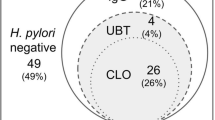Abstract
Although there are several methods to detect Helicobacter pylori infection, there is no simple validated test to quantify the density of infection, which is believed to play a major role in the pathogenesis of H. pylori-associated gastritis and peptic ulceration. The aim of this study was to evaluate and compare noninvasive and invasive tests for assessing the level of H. pylori infection so as to facilitate the development and clinical testing of new antibiotic treatments. Healthy volunteers (n=323) were screened for H. pylori infection by serology and, if positive (n=86), invited to undergo 13C urea breath testing (UBT) (n=55). An increase of >2.4 parts per thousand 13CO2 at 15 min compared to baseline was considered a positive test. Total cumulative urease activity (μmol) at 60 min was also calculated. UBT-positive subjects underwent endoscopy and nine biopsies were obtained from defined sites for quantitative culture and histological grading using the modified Sydney System. A total of 19 subjects were studied, 4 of whom underwent repeat testing. All subjects were positive for H. pylori by serology, UBT, culture, and histology. The increase in 13CO2 at 30 min correlated with the total cumulative urease activity at 60 min (r 2=0.92, P< 0.0001). Bacterial counts (log cfu/biopsy; mean±SD) were 3.9±0.5, 3.9±0.4, and 3.9±0.6 at the lesser curve antrum, greater curve antrum, and corpus, respectively. There was no significant correlation between UBT results and bacterial counts at any biopsy site. Nor was there any significant correlation between the histology grading and either the UBT or the bacterial counts at any site. This study indicates that there is little correlation among the three methods used to measure bacterial burden in H. pylori infection. Thus, decrements in bacterial numbers during single-agent therapy cannot be measured reliably by UBT and therefore cannot be used to evaluate the potential efficacy of novel agents to treat gastric H. pylori infection.

Similar content being viewed by others
References
Graham DY, Lew GM, Klien PD, et al. (1992) Effect of treatment of Helicobacter pylori infection on the long-term recurrence of gastric and duodenal ulcer. Ann Intern Med 116:705–708
Bayerdorfer E, Neubauer A, Rudolph B, et al. (1995) Regression of primary gastric lymphoma of mucosa- associated lymphoid tissue after cure of Helicobacter pylori infection. Lancet 345:1591–1594
Wong BC, Lam SK, Wong WM, Chen JS, Zheng TT, Feng RE, Lai KC, Hu WH, Yuen ST (2004) Helicobacter pylori eradication to prevent gastric cancer in a high-risk region of China: a randomized controlled trial. JAMA 291(2):187–194
Poon SK, Chang CS, Su J, et al. (2002) Primary resistance to antibiotics and its clinical impact on the efficacy of Helicobacter pylori lansoprazole-based triple therapies. Aliment Pharmacol Ther 16(2):291–296
Michetti P, Kreiss C, Kotloff KL, et al. (1999) Oral immunization with urease and Escherichia coli heat- labile enterotoxin is safe and immunogenic in Helicobacter pylori-infected adults. Gastroenterology 116:804–812
Hilker E, Domschke W, Stoll (1996) 13C-urea breath test for detection of Helicobacter pylori and its correlation with endoscopic and histologic findings. J Physiol Pharmacol 47:79–90
Logan RPH, Polson RJ, Misiewicz JJ, et al. (1991) Simplified single sample 13carbon urea breath test for Helicobacter pylori: comparision with histology, culture and ELISA serology. Gut 32:1461–1464
Sheu B-S, Lee S-C, Yang H-B, et al. (1999) Quantitative result of 13C urea breath test at 15 min may correlate with the bacterial density of H. pylori in the stomach. Hepatogastroenterology 46:2057–2062
Ellenrieder V, Glasbrenner B, Stoffels C, et al. (1997) Qualitative and semi-quantitative value of a modified 13C-urea breath test for identification of Helicobacter pylori infection. Eur J Gastroenterol Hepatol 9:1085–1089
Perri F, Clemente R, Pastore M, et al. (1998) The 13 C-urea breath test as a predictor of intragastric bacterial load and severity of Helicobacter pylori gastritis. Scand J Clin Lab Invest 58:19–28
Labenz J, Borsch G, Peitz U, et al. (1996) Validity of a novel biopsy urease test (HUT) and a simplified 13C-urea breath test for diagnosis of Helicobacter pylori infection and estimation of the severity of gastritis. Digestion 57:391–397
Akada JK, Shirai M, Fujii K, et al. (1999) In vitro anti-Helicobacter pylori activities of new rifamycin derivatives, KRM- 1648 and KRM-1657. Antimicrob Agents Chemother 42:1072–1076
Dixon MF, Genta RM, Yardley JH, et al. (1996) Classification and grading of gastritis. The updated Sydney System. International Workshop on the Histopathology of Gastritis, Houston 1994. Am J Surg Pathol 20:1161–1181
Kobayashi D, Eishi Y, Ohkusa T, et al. (2002) Gastric mucosal density of Helicobacter pylori estimated by real- time PCR compared with results of urea breath test and histological grading. Diagn Microbiol 51:305–311
Chang M, Chang Y, Sun T, et al. (2002) Quantitative correlation of Helicobacter pylori stool antigen (HpSA) test with 13C-urea breath test by the updated Sydney System of gastritis. Hepatogastroenterology Mar–Apr 49(44):576–579
Moshkowitz M, Konikoff FM, Peled Y, et al. (1995) High Helicobacter pylori numbers are associated with low eradication rate after triple therapy. Gut 36:845– 847
Sheu B-S, Yang H-B, Su I-J, et al. (1996) Bacterial density of Helicobacter pylori predicts the success of triple therapy in bleeding duodenal ulcer. Gastrointest Endosc 44:683–688
Atherton JC, Tham KT, Peek RM, et al. (1996) Density of Helicobacter pylori infection in vivo as assessed by quantitative culture and histology. J Infect Dis 27:35–41
Lewis JD, Kroser J, Beven J, et al. (1997) Urease-based tests for Helicobacter pylori gastritis—accurate for diagnosis but poor correlation with disease severity. J Clin Gastroenterol 25:415–420
Matthews GM, Cummins AG, Lawrence A, et al. (2005) 13C-Urea breath test: reproducibility and association with the severity of Helicobacter pylori-associated antral gastritis. J Gastroenterol Hepatol 20:270–274
Acknowledgment
This study was funded by ActivBiotics, Lexington, Massachusetts.
Author information
Authors and Affiliations
Corresponding author
Rights and permissions
About this article
Cite this article
Tummala, S., Sheth, S.G., Goldsmith, J.D. et al. Quantifying Gastric Helicobacter pylori Infection: A Comparison of Quantitative Culture, Urease Breath Testing, and Histology. Dig Dis Sci 52, 396–401 (2007). https://doi.org/10.1007/s10620-006-9377-9
Received:
Accepted:
Published:
Issue Date:
DOI: https://doi.org/10.1007/s10620-006-9377-9




